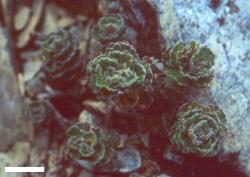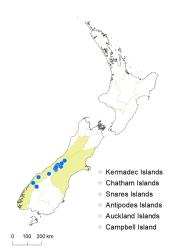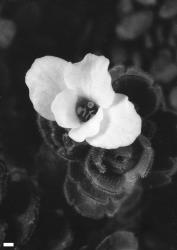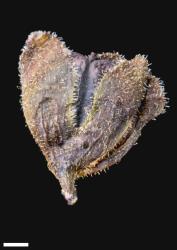- ≡ Parahebe birleyi (N.E.Br.) W.R.B.Oliv., Rec. Domin. Mus. 1: 230 (1944)
- ≡ Hebejeebie birleyi (N.E.Br.) Heads, Bot. Soc. Otago Newsl. 36: 11 (2003)
- = Veronica grahamii Petrie, Trans. & Proc. New Zealand Inst. 45: 273 (1913) – as Grahami
Low sub-shrub to 0.2 m tall. Stems decumbent to ascending, eglandular-pubescent, rarely a few glandular hairs as well; hairs uniform. Leaf bud indistinct; leaves separating while small, opposite-decussate, erecto-patent to spreading; lamina sub-coriaceous, elliptic, oblong, orbicular, broadly obovate, to obtriangular, 4–12 mm long, 2.5–11.0 mm wide, dull dark green to purplish-green above and beneath; veins obscure; surfaces densely eglandular-hairy above and beneath, occasionally with a few long, glandular hairs as well; margins ciliate, deeply crenate to lobed; lobes in 1–3 pairs; apex obtuse, rounded, truncate, or retuse; base cuneate; petiole 0–1 mm long. Inflorescence a lateral raceme 2–5 mm long or a solitary bibracteate flower; flowers distant, 2–3 or rarely solitary, all bisexual; bracts opposite, narrowly spathulate, > pedicels; pedicels erecto-patent, 0.3–1.5 mm long, eglandular-hairy all around. Calyx lobes 4, sub-acute or obtuse, 4–6 mm long, equal, mixed eglandular- and glandular-hairy. Corolla 7–10 mm diameter; tube white and greenish-yellow, 3–4 mm long, < calyx, glabrous; lobes 5, sometimes 4, white, spreading to recurved, unequal, elliptic to orbicular, 3–5 mm long, obtuse to rounded; nectar guides absent. Stamen filaments white, 2–3 mm long; anthers pink, magenta, or purplish. Style glabrous, 1.0–1.5 mm long. Capsules angustiseptate, emarginate, glabrous, 3–4 mm long, 3–4 mm at widest point. Seeds elliptic to obovate, flattened, smooth, buff to brown, 0.6–1.0 mm long.
V. birleyi and three similar species, V. spectabilis, V. densifolia, and V. trifida, are placed together in the snow hebe group. Veronica birleyi is distinctive. The unusual combination of broad, blunt, dull dark green, hairy leaves, often purplish (especially beneath), white solitary flowers, or 2 to 3 together, and short stamens and style enclosed in the corolla tube, is shared only with V. spectabilis, to which it is probably closely related. So far as is known, V. spectabilis plants are generally larger, and differ in having a higher proportion of glandular hairs on the leaves and inflorescences, longer inflorescences (10–25 mm long), much larger flowers (18–25 mm diameter), usually with 4 corolla lobes, and hairy capsules. In V. spectabilis the longer peduncles and pedicels tend to cause the flowers to be more exserted than they are in V. birleyi. The related V. trifida and V. densifolia are similar, but have bronze or yellowish leaves, which are narrower, and in V. densifolia usually entire.
(See: Morphological features to distinguish the snow hebes in Veronica sensu lato: i.e. Chionohebe, Hebejeebie, Parahebe p.p.)
| birleyi | spectabilis | trifida | densifolia | thomsonii | pulvinaris | chionohebe | ciliolata |
|---|---|---|---|---|---|---|---|---|
Habit | lax sub-shrub | lax sub-shrub | lax sub-shrub | lax sub-shrub | cushion plant | cushion plant | cushion plant | cushion plant |
Stem hairs | eglandular & a few glandular, spreading | mixed glandular & eglandular, spreading | eglandular, retrorse | eglandular, retrorse | glabrous | glabrous | glabrous | glabrous |
Leaf size (mm) | 4.0–12 × 2.5–11 | 4.5–13 × 2.5–6.0 | 2–10 × 1–7 | 2–6.5 × 0.7–3 | 1.7–4.7 × 0.7–2.6 | 1.8–4.8 × 0.5–2 | 1.75–5 × 0.75–2.25 | 1.75–4.5 × 0.8–2.8 |
Leaf margins | deeply crenate to lobed | deeply crenate to lobed | shallowly toothed to lobed, rarely entire | usually entire, rarely 1–2 teeth or lobes | entire | entire | entire | entire |
Lamina | subcoriaceous, flat; margin not thickened, smooth | subcoriaceous, flat; margin not thickened, smooth | subcoriaceous, flat; margin not thickened, smooth | coriaceous, keeled, with thickened papillate margin | thin, flat; margin not thickened, smooth | thin, flat; margin not thickened, smooth | thin, flat; margin not thickened, smooth | thin, flat; margin not thickened, smooth |
Leaf hairs: adaxial | scattered eglandular | mixed eglandular & glandular | glabrous | glabrous | eglandular: in broad band across middle, occasionally scattered distally | eglandular appressed: scattered or in a central patch on distal half | absent | absent or isolated and scattered in distal ½ |
Leaf hairs: abaxial | scattered eglandular | mixed eglandular & glandular | glabrous | glabrous | glabrous, or stiff, eglandular, isolated distal hairs | glabrous or eglandular appressed scattered distally | absent or isolated in distal ½ | absent or isolated and scattered in distal ½ |
Leaf hairs: margin | eglandular-ciliate | mixed eglandular & glandular-ciliate | long glandular-ciliate | stiff eglandular-ciliate | ciliate in basal ⅔ with apical tuft | eglandular appressed: ciliate | absent or scattered cilia | ciliate throughout or in basal or distal half, usually with apical tuft |
Sexual system | cosexual | cosexual | cosexual | cosexual | dioecious | dioecious | dioecious | dioecious |
Inflorescence | 2–3 flowers, sometimes solitary bibracteolate | 2–3 flowers, sometimes solitary bibracteolate | 2–3 flowers, sometimes solitary bibracteolate | solitary bibracteolate | solitary bibracteolate | solitary bibracteolate | solitary bibracteolate | solitary bibracteolate |
Peduncle (mm) | 2–4 | 5–15 | 2–10 | 0 | 0 | 0 | 0 | 0 |
Pedicel (mm) | 0.3–1.5 | 2.5–5 | 0.5–7 | 0 | 0 | 0 | 0 | 0 |
Calyx lobes | 4 | 4 | 4 | 5 | 5 | 5 | 5 | 5 |
Corolla lobes | (4–)5(–6) | 4(–5) | 5(–6) | 5(–6) | 5 | 5 | 5 | 5 |
Corolla diameter (mm) | 7–10 | 18–25 | 15–20 | 7–16 | 2.5–5 | 2.5–6 | 1.5–4.1 | 2.1–6.5 |
Corolla shape | funnelform | funnelform | funnelform | funnelform | rotate | rotate | rotate | rotate |
Capsule size (mm) | 3–4 × 3–4 | 4–5 × 4–5 | 4.5–6 × 2.5–3 | 2.7–5 × 1.7–4.25 | 1.5–3 × 1–2 | 1–3 × 1.2–2.7 | 1.9–2.5 × 1.5–1.9 | 2.5–3.5 × 1.4–3.1 |
Capsule hairs | glabrous | mixed glandular & eglandular-hairy at apex | glandular-ciliate, sometimes glabrous | glabrous | glabrous to densely hairy at apex | eglandular-hairy, especially at apex | absent | absent or apical |
South Island: Canterbury, Westland, Otago (Remarkables), Southland (Eyre Mountains), Fiordland; mostly along and close to the main divide from Mt Westland to Mt Tūtoko.
Nival rock crevices. Recorded elevations range from 1830 to 2835 m.
Flowers: December–March; fruits: January–March.
2n = 42 (Hair 1970).
Veronica birleyi is classified in V. subg. Pseudoveronica sect. Hebe and informally in the “snow hebe” group (Albach & Meudt 2010). It has not been included in molecular phylogenetic studies so far; records under the name Parahebe birleyi refer to material of V. spectabilis. Morphological similarities suggest a close relationship to V. spectabilis, and it is likely these are allopatric sister species. Its wider relationships are with V. trifida and V. densifolia and the cushion snow hebes (e.g., V. pulvinaris).
V. birleyi is one of a trio that attains the highest altitudes of flowering plants in New Zealand, about 2900 m (the others are V. epacridea and Ranunculus grahamii).







